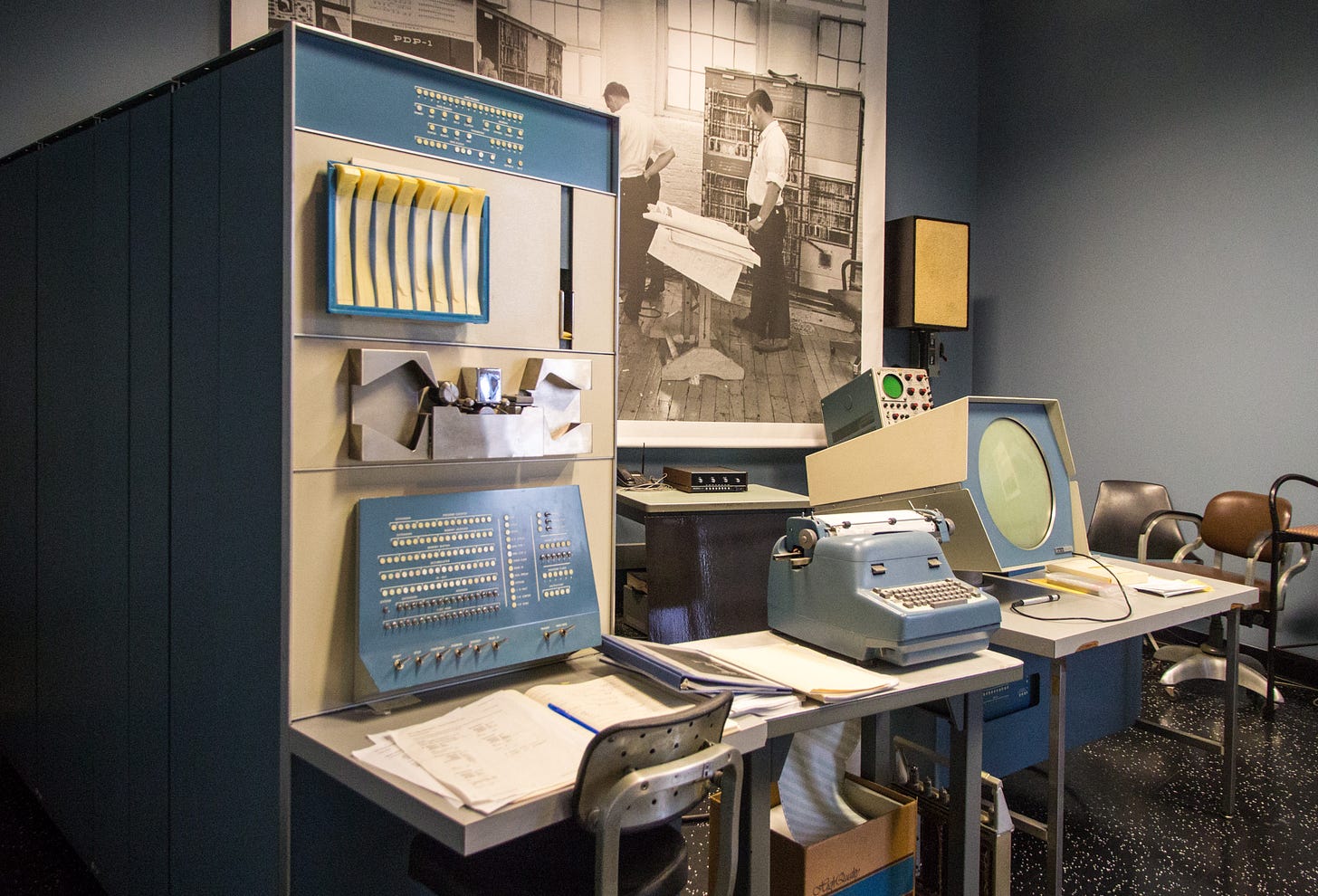Marketing in 2025
Customers don’t care about you - much less your product

My last two newsletters consolidated a recurring theme running through my thinking and writing over the past couple of years. In case you missed them …
To which a few of you have commented ( I paraphrase)
“Very good John - so what? How does all of that translate into practical advice?
This is one of my many responses - because it’s not just about marketing - but its not a bad place to start …
In the age of mass production, mass media, and mass markets, a period I call ‘The Age of Reason’ - marketers leaned heavily on McCarthy’s ‘4Ps’; product, place, price, and promotion. If you’ve studied marketing, you’ve seen them. McCarthy first wrote about them in 1960 - sixty-five years ago, the same year DEC released the PDP-1, ‘mini-computer’ that eventually gave way to the PDP-11 in the 1990s.

The new mini computers were used in many different ways, but in commerce, those early systems had one job: record-keeping. They grew into ERP and accounting platforms and became the backbone of business IT - what we now call ‘Systems of Record’.
Back then - and still too often today - business obsessed over control and management. Success was counted in widgets: how many, how fast, where they were. Forecasting became the holy grail, feeding our endless urge to control our world. That mindset married perfectly with systems of record: tallying, tracking, predicting. Life was great and predictable - and good. And then it wasn’t.
Because in a world where corporate assets are reduced to ‘money’, ‘things’, and ‘people’ - and the first two already had solid systems to manage them, well - it was ‘obvious’ that the third ‘asset class’ should fold into the same approach. Right
Enter HRIS, then SFA, and soon CRM. The common denominator? People. And I’d argue this: If those systems were seen to work for the organisation that implemented them, then that organisation was under some very mistaken impressions and were likely;
measuring the wrong thing
mistaking compliance for performance
confusing activity with impact
confusing control with capability
counting what’s easy - not what matters
rewarding box-ticking - not real results
or worse - all of the above.
Put bluntly: these systems thrived because they gave management what they wanted (numbers, reports, predictability), not what people needed (clarity, connection, purpose).
It gets even worse.
As soon as they could (that would be in the 1970s), organisations turned computer power toward ‘marketing at scale’. And ‘we the people’ got the fallout: catalogues, direct mail, loyalty schemes. Primitive by today’s standards, but driven by the same intent - reduce people to records to be targeted, segmented, and pushed. The 4Ps, AIDA, and other ‘proven’ formulas supplied the scaffolding the machines were coded to obey.
It rolled on through generation after generation of so-called people systems, first SFA then CRM, then HRIS - because if you can reduce customers to records to manage - why not staff too?1
And it has never got better. Easier? Yes. More flexible? Absolutely. But better for ‘we the people’? Not at all. It’s so bad that you can still find people writing about the customer journey as if it were linear, predictable, and controllable - when every lived experience screams the opposite.
Which brings me to this transition we are moving through.
The 4Ps were born in a world obsessed with control, scale, and efficiency. Businesses looked inward, measuring inventory, transactions, and compliance. Customers were barely in the frame (thought to be fair - the 4Ps were extended to the 7Ps in the early 80s - and today they’ve stretched to 10. More levers, same broken system.
Fast forward to 2025, and I think we can all agree that the mindset is obsolete. We no longer live in the Age of Reason - we live in the Age of Experience and such transcendence begs for a new model. A model that works in the Age of Experience.
Introducing The 4Es
Engagement Marketing is now in charge.
In 2025 we live in the Age of Experience. The old 4P framing hasn’t held for years and today is irrelevant. Today we look through the lens of
solutions, not products
value, not price
convenience, not place;
education and dialogue, not promotion
… because Customers aren’t passive - they are active participants shaping the exchange.
Essence
Who you are and why you matter.
Your purpose, values, and the human problem you exist to solve.
People buy the why, before they buy the what.
Exchange
The mutual value created.
Customers give more than money, they trade time, trust, data, and attention. In return they expect outcomes, solutions, and belonging.
Marketing is a relationship, not a transaction.
Ease
Frictionless access.
How simple is it to find you, use you, trust you, leave you, or return?
In systems of engagement, convenience equals commitment.
Experience
The lived reality of the relationship.
Every touchpoint markets who you are: a help desk call, an onboarding email, an invoice.
If your marketing still runs on levers built in the 1960s, it’s time to move.
The 4Es aren’t theory, they’re survival.
I’ll get to the ‘sales funnel’, the flywheel and how all this connects with all that next time. Until then - to borrow from Geoffrey Moore;
That’s What I Think - What Do You Think?
If you want to talk more - I certainly do.
Let's set up some time to explore how Structured Thought can be used to help your business transition into the ‘Age of Experience’.
I know I made this point a few paragraphs before this, but it’s worth repeating because some points deserve to be hammered in, not just noted - and this point is so important that it will be built on in a future article.




It's funny — I know what you say here to be true, and this is the approach I use in my business. I get a lot of positive feedback on our why, and constantly have customers telling us they chose to go with us because of that.
But I guess I'm a jaded old fart. I'll listen to your why, out of courtesy, but I want to know the what and the how. About the worst thing you can do trying to sell me something is start telling me about all the benefits before you've even told me how it works and how it's differentiated. Don't waste my time up front with the warm fuzzies — we can get to that later if you actually grab my interest with the details.
Good thing I know I'm not my customer. :-)